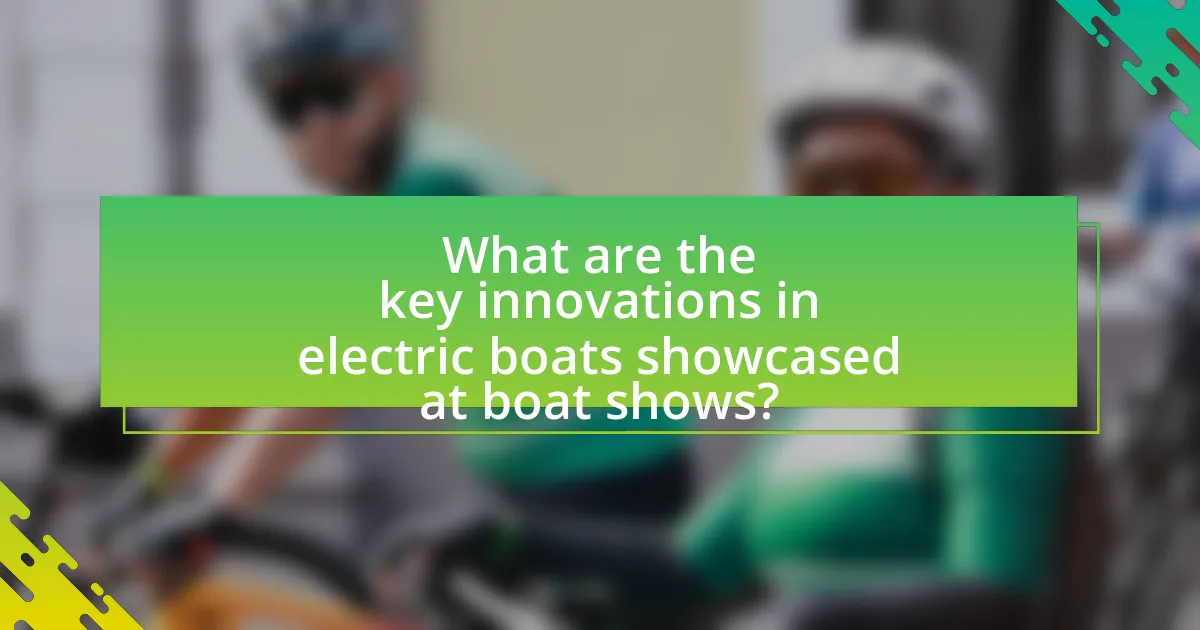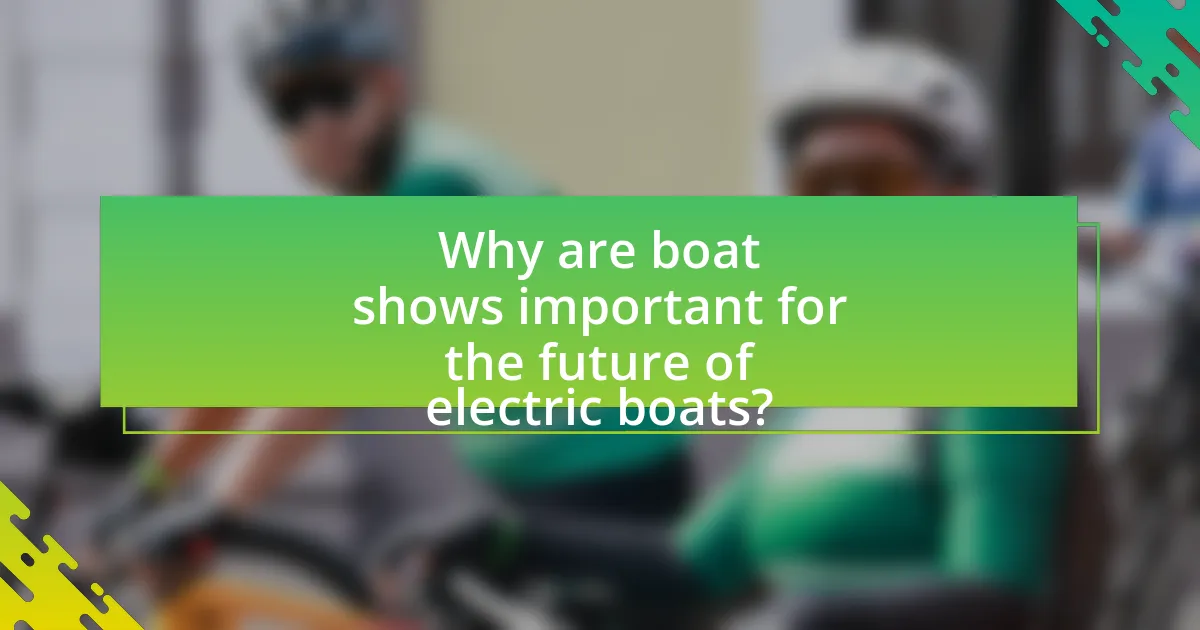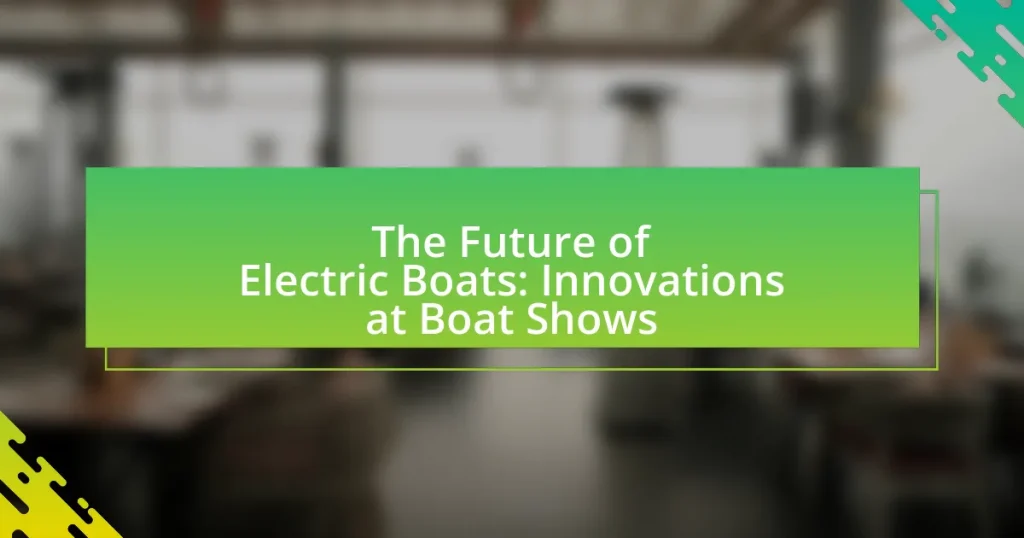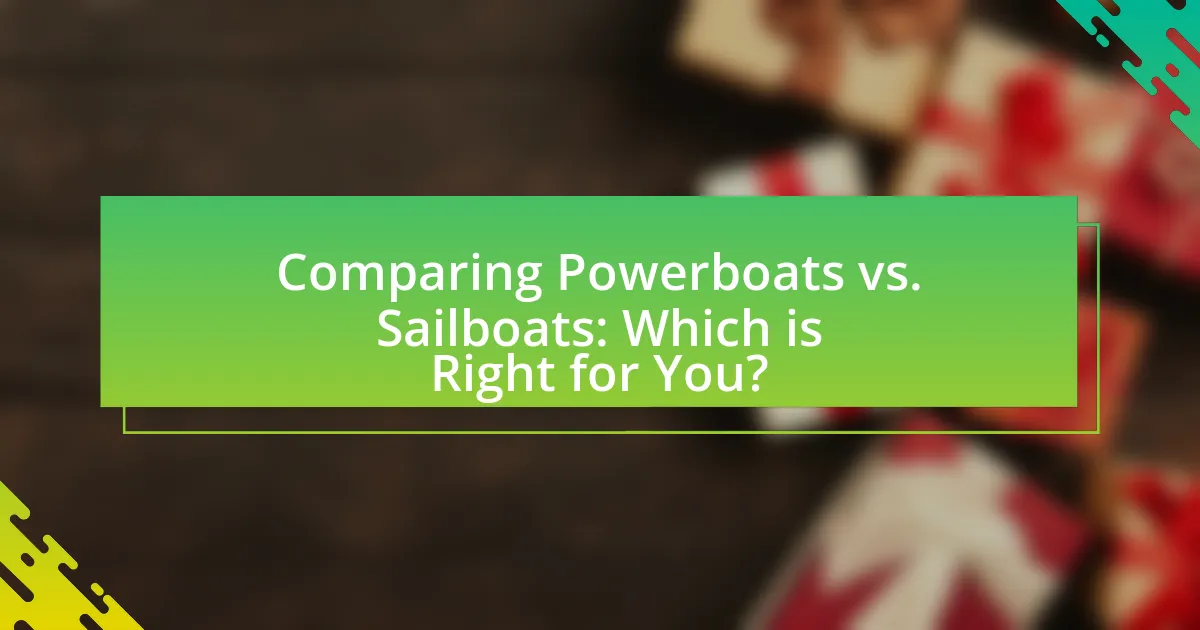The article focuses on the future of electric boats, highlighting key innovations showcased at boat shows, including advanced battery technology, integrated solar panels, and enhanced propulsion systems. It discusses the evolution of electric boat design and technology, emphasizing the use of lightweight materials and smart technologies that improve performance and sustainability. The article also addresses safety innovations, the importance of boat shows for industry collaboration and consumer education, and the challenges electric boats face in the market, such as high initial costs and regulatory hurdles. Additionally, it provides insights for consumers considering electric boats, including performance assessment and warranty considerations.

What are the key innovations in electric boats showcased at boat shows?
Key innovations in electric boats showcased at boat shows include advanced battery technology, integrated solar panels, and enhanced propulsion systems. Advanced battery technology, such as lithium-sulfur batteries, offers higher energy density and faster charging times, significantly improving the range and efficiency of electric boats. Integrated solar panels allow for renewable energy generation while on the water, reducing reliance on shore power and extending operational time. Enhanced propulsion systems, including electric outboard motors and hybrid systems, provide better performance and maneuverability, making electric boats more competitive with traditional combustion-engine vessels. These innovations reflect the industry’s commitment to sustainability and efficiency in marine transportation.
How are electric boats evolving in design and technology?
Electric boats are evolving significantly in design and technology through advancements in battery efficiency, lightweight materials, and integrated smart systems. Recent innovations include the development of solid-state batteries, which offer higher energy density and faster charging times compared to traditional lithium-ion batteries, enhancing the range and performance of electric boats. Additionally, manufacturers are utilizing advanced composite materials to reduce weight and improve fuel efficiency, while smart technology integration allows for real-time monitoring of performance and energy consumption. These advancements are evident in models showcased at boat shows, where companies like X Shore and Candela have introduced electric vessels that exemplify these cutting-edge features, demonstrating a clear trend towards more sustainable and efficient boating solutions.
What materials are being used to enhance electric boat performance?
Advanced composite materials, such as carbon fiber and fiberglass, are being used to enhance electric boat performance. These materials provide a high strength-to-weight ratio, which improves speed and efficiency while reducing energy consumption. Additionally, lightweight metals like aluminum and innovative materials such as bio-resins are being incorporated to further optimize the structural integrity and sustainability of electric boats. The use of these materials contributes to better overall performance metrics, including increased range and maneuverability, as evidenced by various electric boat prototypes showcased at recent boat shows.
How do advancements in battery technology impact electric boats?
Advancements in battery technology significantly enhance the performance and viability of electric boats. Improved battery energy density allows for longer ranges, enabling electric boats to travel greater distances without the need for frequent recharging. For instance, lithium-ion batteries have seen energy densities increase from around 150 Wh/kg to over 300 Wh/kg in recent years, which directly translates to extended operational time on the water. Additionally, advancements in fast-charging capabilities reduce downtime, allowing electric boats to recharge more quickly, thus increasing their usability for recreational and commercial purposes. These technological improvements not only make electric boats more competitive with traditional fuel-powered vessels but also contribute to reduced environmental impact by promoting cleaner energy use in marine transportation.
What features are most highlighted in electric boat presentations?
Electric boat presentations most commonly highlight features such as eco-friendliness, advanced battery technology, and innovative design. Eco-friendliness is emphasized due to the growing demand for sustainable boating solutions, with electric boats producing zero emissions compared to traditional fuel-powered vessels. Advanced battery technology is showcased, often detailing improvements in energy density and charging speed, which enhance the range and usability of electric boats. Innovative design elements, including sleek aesthetics and user-friendly interfaces, are also prominently featured, reflecting the integration of modern technology and consumer preferences in the boating industry. These highlighted features collectively demonstrate the shift towards more sustainable and efficient boating options.
How do smart technologies integrate into electric boats?
Smart technologies integrate into electric boats through advanced systems that enhance navigation, energy management, and user experience. These technologies include GPS-based navigation systems, automated control systems, and real-time monitoring of battery performance. For instance, electric boats often utilize smart sensors to optimize energy consumption, allowing for efficient route planning and reduced operational costs. Additionally, integration with mobile applications enables users to monitor their boat’s status remotely, providing insights into battery levels and maintenance needs. This integration of smart technologies not only improves the functionality of electric boats but also aligns with the growing trend of digitalization in the maritime industry.
What safety innovations are being introduced for electric boating?
Safety innovations for electric boating include advanced battery management systems, collision avoidance technology, and improved fire suppression systems. These innovations enhance operational safety by monitoring battery health to prevent overheating and fires, utilizing radar and sonar for obstacle detection, and implementing automatic fire extinguishing systems to mitigate risks associated with battery malfunctions. For instance, companies like Torqeedo have integrated smart battery management systems that provide real-time data on battery status, significantly reducing the likelihood of accidents.

Why are boat shows important for the future of electric boats?
Boat shows are crucial for the future of electric boats because they serve as platforms for showcasing innovations, fostering industry collaboration, and educating consumers. These events allow manufacturers to present the latest advancements in electric propulsion technology, battery efficiency, and sustainable materials, which are essential for attracting investment and consumer interest. For instance, the Miami International Boat Show has featured electric models from leading brands, demonstrating the growing market presence of electric boats. Additionally, boat shows facilitate networking among industry stakeholders, enabling partnerships that can accelerate the development and adoption of electric boating solutions.
How do boat shows influence consumer perceptions of electric boats?
Boat shows significantly influence consumer perceptions of electric boats by providing firsthand experiences and showcasing technological advancements. These events allow consumers to interact with electric boats, observe their features, and understand their benefits, which can enhance their acceptance and interest in this emerging market. For instance, a study by the National Marine Manufacturers Association found that 70% of attendees at boat shows reported increased interest in electric boating options after experiencing them in person. This direct engagement helps demystify electric technology, dispel misconceptions, and foster a positive attitude towards electric boats among potential buyers.
What role do demonstrations play in showcasing electric boat capabilities?
Demonstrations play a crucial role in showcasing electric boat capabilities by providing real-time evidence of performance, efficiency, and technological advancements. These live displays allow potential buyers and industry stakeholders to observe the boats in action, highlighting features such as speed, maneuverability, and environmental benefits. For instance, events like the Miami International Boat Show have featured electric boats that demonstrate reduced noise levels and zero emissions, reinforcing the advantages of electric propulsion over traditional engines. Such demonstrations not only validate manufacturers’ claims but also enhance consumer confidence in adopting electric boating technologies.
How do industry experts use boat shows to forecast trends?
Industry experts use boat shows to forecast trends by analyzing consumer interest, product innovations, and industry presentations. At these events, experts observe which types of boats attract the most attention, noting features that resonate with attendees, such as electric propulsion systems and eco-friendly materials. For instance, the 2023 Miami International Boat Show highlighted a significant increase in electric boat displays, indicating a shift towards sustainable boating solutions. This data allows experts to identify emerging trends and predict future market demands, as evidenced by the growing number of manufacturers investing in electric technology, reflecting a broader industry transition towards sustainability.
What networking opportunities arise from boat shows for electric boat manufacturers?
Boat shows provide electric boat manufacturers with significant networking opportunities, including connections with potential buyers, industry partners, and suppliers. These events facilitate direct interactions with consumers interested in sustainable boating, allowing manufacturers to showcase their innovations and gather feedback. Additionally, manufacturers can engage with other industry stakeholders, such as technology developers and environmental organizations, fostering collaborations that can enhance product development and market reach. The presence of media at boat shows also offers manufacturers exposure, which can lead to increased visibility and credibility in the market.
How do collaborations formed at boat shows drive innovation?
Collaborations formed at boat shows drive innovation by facilitating partnerships between manufacturers, designers, and technology providers, leading to the development of advanced electric boat technologies. These events create a unique environment where stakeholders can share insights, showcase new ideas, and combine resources, resulting in innovative solutions that enhance performance, sustainability, and user experience. For instance, collaborations at boat shows have led to the integration of cutting-edge battery technologies and eco-friendly materials, significantly improving the efficiency and environmental impact of electric boats.

What challenges do electric boats face in the market?
Electric boats face several challenges in the market, primarily including limited battery technology, high initial costs, and regulatory hurdles. Limited battery technology restricts the range and performance of electric boats compared to traditional fuel-powered vessels, making them less appealing for long-distance travel. High initial costs deter potential buyers, as electric boats often have a higher price point due to expensive components like batteries and electric motors. Regulatory hurdles, such as varying environmental regulations across regions, can complicate the adoption and manufacturing processes for electric boats. These challenges collectively hinder the widespread acceptance and growth of electric boats in the marine market.
How does the cost of electric boats compare to traditional boats?
Electric boats generally have a higher upfront cost compared to traditional boats, primarily due to the expense of battery technology and electric propulsion systems. For instance, electric boats can range from $50,000 to over $1 million, while traditional gasoline-powered boats typically start around $20,000 and can exceed $500,000 for luxury models. This price difference is influenced by the growing demand for sustainable technology and the initial investment in electric infrastructure. Additionally, operating costs for electric boats tend to be lower over time, as they require less maintenance and benefit from lower fuel costs, which can offset the initial purchase price.
What factors contribute to the pricing of electric boats?
The pricing of electric boats is influenced by several key factors, including battery technology, materials used in construction, manufacturing costs, and market demand. Battery technology plays a significant role, as advanced batteries with higher energy density and longer life cycles tend to increase the overall cost of the boat. The materials used, such as lightweight composites or aluminum, also affect pricing due to their impact on performance and durability. Manufacturing costs, which encompass labor, production processes, and economies of scale, further contribute to the final price. Lastly, market demand can drive prices up or down, as increased interest in sustainable boating solutions often leads to higher valuations for electric boats.
How can manufacturers reduce costs while maintaining quality?
Manufacturers can reduce costs while maintaining quality by implementing lean manufacturing techniques and investing in automation. Lean manufacturing focuses on minimizing waste and optimizing processes, which can lead to significant cost savings. For instance, companies that adopt lean principles often report a reduction in production costs by 20-30% while improving product quality. Automation, such as robotics and advanced manufacturing technologies, enhances precision and efficiency, further lowering costs and ensuring consistent quality. According to a study by the McKinsey Global Institute, automation can increase productivity by up to 30%, allowing manufacturers to maintain high standards without incurring additional expenses.
What regulatory hurdles must electric boat manufacturers overcome?
Electric boat manufacturers must overcome regulatory hurdles related to safety standards, emissions regulations, and certification processes. Safety standards require compliance with maritime safety regulations, which can vary by region and necessitate rigorous testing of electrical systems and battery safety. Emissions regulations are increasingly stringent, particularly in environmentally sensitive areas, compelling manufacturers to ensure their vessels meet specific environmental performance criteria. Additionally, certification processes often involve lengthy approvals from maritime authorities, which can delay product launches and increase costs. These regulatory challenges are critical for ensuring that electric boats are safe, environmentally friendly, and commercially viable.
How do environmental regulations impact electric boat design?
Environmental regulations significantly influence electric boat design by mandating stricter emissions standards and promoting sustainable materials. These regulations drive manufacturers to innovate in battery technology, propulsion systems, and hull designs to minimize environmental impact. For instance, the International Maritime Organization’s regulations on greenhouse gas emissions compel electric boat designers to enhance energy efficiency and reduce reliance on fossil fuels. Consequently, this leads to advancements in lightweight materials and improved aerodynamics, which are essential for optimizing performance while adhering to environmental standards.
What are the best practices for consumers considering electric boats?
Consumers considering electric boats should prioritize understanding their specific needs and the available technology. Researching battery life, charging infrastructure, and maintenance requirements is essential, as electric boats often have different operational characteristics compared to traditional boats. For instance, consumers should evaluate the range of electric boats, which can vary significantly; many models now offer ranges between 30 to 100 nautical miles on a single charge, depending on the battery capacity and motor efficiency. Additionally, consumers should consider the total cost of ownership, including initial purchase price, potential savings on fuel, and government incentives for electric vehicle purchases, which can significantly reduce overall expenses. Engaging with manufacturers at boat shows can provide firsthand insights into the latest innovations and technologies, allowing consumers to make informed decisions based on real-time demonstrations and expert advice.
How can potential buyers assess the performance of electric boats at shows?
Potential buyers can assess the performance of electric boats at shows by conducting hands-on tests, observing demonstrations, and engaging with manufacturers. Hands-on tests allow buyers to experience the boat’s handling, speed, and maneuverability directly. Observing live demonstrations provides insights into the boat’s capabilities, such as acceleration and battery efficiency. Engaging with manufacturers enables buyers to ask specific questions about performance metrics, such as range, charging time, and power output, which are critical for understanding the boat’s operational efficiency.
What should consumers look for in terms of warranty and support for electric boats?
Consumers should look for comprehensive warranty coverage and responsive customer support when considering electric boats. A robust warranty typically includes coverage for the battery, motor, and other essential components, often extending for several years, which is crucial given the high costs associated with electric propulsion systems. Additionally, consumers should ensure that the manufacturer provides accessible customer support, including technical assistance and service options, to address any issues that may arise during ownership. Research indicates that manufacturers offering at least a two-year warranty on key components and a dedicated support line significantly enhance customer satisfaction and trust in the product.





